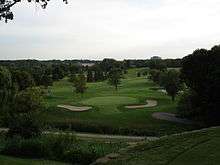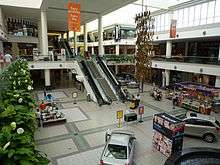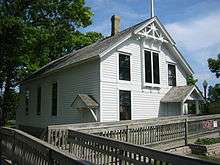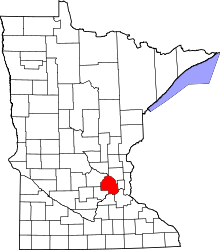Edina, Minnesota
| Edina, Minnesota | ||
|---|---|---|
| City | ||
|
The Edina Theater in September 2006 | ||
| ||
| Motto: "For Living, Learning, Raising Families & Doing Business" | ||
 Location of Edina within Hennepin County, Minnesota | ||
| Coordinates: 44°53′44″N 93°21′17″W / 44.89556°N 93.35472°WCoordinates: 44°53′44″N 93°21′17″W / 44.89556°N 93.35472°W | ||
| Country | United States | |
| State | Minnesota | |
| County | Hennepin | |
| Founded | 1860s | |
| Incorporated | 1888 | |
| Government | ||
| • Mayor | James B. Hovland (DFL)[1] | |
| Area[2] | ||
| • City | 15.97 sq mi (41.36 km2) | |
| • Land | 15.45 sq mi (40.02 km2) | |
| • Water | 0.52 sq mi (1.35 km2) 3.26% | |
| Elevation | 922 ft (281 m) | |
| Population (2010)[3] | ||
| • City | 47,941 | |
| • Estimate (2015)[4] | 50,138 | |
| • Rank | US: 754th MN: 19th | |
| • Density | 3,103.0/sq mi (1,198.1/km2) | |
| • Metro | 3,524,583 (US: 16th) | |
| Time zone | CST (UTC-6) | |
| • Summer (DST) | CDT (UTC-5) | |
| ZIP codes | 55410, 55416, 55424, 55435, 55436, 55439, 55343 | |
| Area code(s) | 952 | |
| FIPS code | 27-18188 | |
| GNIS feature ID | 0643177[5] | |
| Website | City of Edina | |
Edina (![]() i/iːˈdaɪnə/ ee-DY-nə) is a city in Hennepin County, Minnesota, United States, and a suburb situated immediately southwest of Minneapolis. Edina began as a small farming and milling community in the 1860s. The population was 47,941 as of 2010.[6]
i/iːˈdaɪnə/ ee-DY-nə) is a city in Hennepin County, Minnesota, United States, and a suburb situated immediately southwest of Minneapolis. Edina began as a small farming and milling community in the 1860s. The population was 47,941 as of 2010.[6]
History
Settlement
Edina began as part of Richfield Township, Minnesota. By the 1870s, 17 families, most of them immigrating as a result of the potato famine in Ireland, had come to Minnesota and claimed land in the southwest section of what was then Richfield Township.[7] They were followed by settlers from New England and Germany, who claimed additional land near Minnehaha Creek.[8] The Baird and Grimes neighborhoods (which are both listed on the National Register of Historic Places), and the Country Club District (then known as Waterville Mills) are located in the northeast part of Edina, and were among the first areas to be established. The area then known as the Cahill Settlement, at West 70th Street and Cahill Road, was also an early community center and the home of Cahill School.[9]
In 1888, the residents of the township held a meeting to consider founding a new village, thus separating themselves from Richfield Township. The idea was favorably accepted by those within the community and a committee was established to oversee the transition.[10]
Naming
After the decision was made to form a new village, a debate ensued regarding the naming of the new village. Several town meetings were held in the Minnehaha Grange Hall, during which the names "Hennepin Park", "Westfield" and "Edina" were suggested. Minutes taken by Henry F. Brown, a farmer and future owner (1889) of the Edina Mill, are summarized as follows:[11]
| “ | "A long debate ensued with regard to the name by which the corporation shall be called. A motion was made and passed to reconsider the vote taken at the previous meeting of the name of the proposed village, Westfield. Another motion was then made by Andrew Craik to call the proposed village Edina (upon moving to the township in 1869 from Edinburgh, he bought and renamed the mill to the Edina Mill). Before the motion could be decided, James A. Bull, a member of the five person committee, made another motion to adjourn, which was seconded by the majority. However, the chairman of the meeting called this motion out of order, at which time disorder ensued with Baird, Wilson, Ryan and Bull declaring their intent to no longer serve as members of the committee if a gag law was to prevail. During this heated moment the meeting became somewhat boisterous until, after a few minutes order was restored. Seeing that no more work could be done at this time, a final motion was made and passed to reschedule the meeting to a future date." | ” |
At the next meeting, the name Edina was finally chosen with a vote of 47 for and 42 against.[10]
There has been a prevailing myth about the decision to name the new village Edina, which states that two opposing communities—the Irish Cahill community and the Scottish Mill community fought about whether to give the community an Irish name (Killarney Lakes) or a Scottish name (Edina). The 1860 census, however, indicates that there were no Scottish people in Edina in 1860, and only a couple were present at the time of Edina's founding (1888).[8]
Morningside
The first suburban development in Edina occurred during the early 1900s in Morningside, a neighborhood in the northeastern part of the village. As Morningside grew, conflict arose between its residents who wanted more city services, and the residents of the rest of the village who wanted to maintain Edina's rural character. As a result of that conflict, Morningside seceded from Edina in 1920 and became a separate village.[12] In 1966, however, the Village of Morningside once again became part of Edina.[13]
Historical racial discrimination
According to historian Deborah Morse-Kahn, the Quaker village that existed where Edina would be built included African Americans who "became very involved in community life—especially as leaders."[14] At the November 1898 general election, J. Frank Wheaton, a Republican African-American, was elected to the Minnesota House of Representatives representing District 42, which included all of Edina. Wheaton beat his white Democratic opponent in every city of Minneapolis ward and in every village within the legislative district, including Edina, even though the legislative district had only approximately 100 African Americans residents out of a total of 40,000 residents.[15]
In the early 20th century discriminatory policies led nearly all of the African Americans who had been living in Edina to move away.[14][16][17] James W. Loewen described the suburb as a sundown town.[18] Researchers point in particular to Samuel Thorpe's development of the Country Club district, which used deed restrictions as means to exclude non-whites, stating explicitly that:
| “ | "No lot shall ever be sold, conveyed, leased, or rented to any person other than one of the white or Caucasian race, nor shall any lot ever be used or occupied by any person other than one of the white or Caucasian race, except such as may be serving as domestics for the owner or tenant of said lot, while said owner or tenant is residing thereon."[14][18][19][20][21] | ” |
Other developments, like that built by N. P. Dodge Corporation just a mile away, followed suit in attempting to protect land values through racial policies.[22] Though the Supreme Court ruled these kinds of discriminatory housing clauses unenforceable in its Shelley v. Kraemer decision of 1948, reports of discrimination persisted through the 1950s and 1960s.[14][17] According to the Edina Historical Society's story about the first black family in Morningside (then a separate village) in 1960, attempts to keep them out included tactics like trying "to get [their] lot condemned for drainage."[17] In response, then-mayor Ken Joyce wrote a note dismissing the drainage concern and challenging citizens "to live the Golden Rule". Shortly thereafter the village voted in favor of inclusion.[17]
Jewish residents were also affected by exclusionary deed covenants. In the 1960s, some residents boasted that Edina had "Not one Negro and not one Jew."[23]
Geography
Many major highways run through or are close to Edina, making it readily accessible to those within the metropolitan area. Minnesota State Highways 62 and 100 divide the City into four sections. U.S. Highway 169 and Minnesota State Highway 100 extend north and south. Interstate 494 and Minnesota State Highway 62 extend east and west.[24]
According to the United States Census Bureau, the city has a total area of 15.97 square miles (41.36 km2), of which 15.45 square miles (40.02 km2) is land and 0.52 square miles (1.35 km2) is water.[2] Residential areas comprise the largest portion of the City, which is now more than 95 percent developed. Within Edina are many different neighborhoods; Highlands, Indian Hills, Morningside, Country Club District, Cahill Village, Chapel Hill, South Harriet Park, Interlachen, Rolling Green, Sunnyslope, White Oaks, Parkwood Knolls, Braemar Hills, Birchcrest, Dewey Hill and Hilldale.[25]
Demographics
| Historical population | |||
|---|---|---|---|
| Census | Pop. | %± | |
| 1890 | 531 | — | |
| 1900 | 749 | 41.1% | |
| 1910 | 1,101 | 47.0% | |
| 1920 | 1,833 | 66.5% | |
| 1930 | 3,138 | 71.2% | |
| 1940 | 5,855 | 86.6% | |
| 1950 | 9,744 | 66.4% | |
| 1960 | 30,482 | 212.8% | |
| 1970 | 44,031 | 44.4% | |
| 1980 | 46,073 | 4.6% | |
| 1990 | 46,075 | 0.0% | |
| 2000 | 47,425 | 2.9% | |
| 2010 | 47,941 | 1.1% | |
| Est. 2015 | 50,138 | [26] | 4.6% |
| U.S. Decennial Census[27] 2015 Estimate[4] | |||
As of the census[3] of 2010, there were 47,941 people, 20,672 households, and 12,918 families residing in the city. The population density was 3,103.0 inhabitants per square mile (1,198.1/km2). There were 22,560 housing units at an average density of 1,460.2 per square mile (563.8/km2). The racial makeup of the city was 88.1% White, 3.0% African American, 0.2% Native American, 6.1% Asian, 0.7% from other races, and 1.8% from two or more races. Hispanic or Latino of any race were 2.3% of the population.[3]
There were 20,672 households of which 29.4% had children under the age of 18 living with them, 53.7% were married couples living together, 6.4% had a female householder with no husband present, 2.3% had a male householder with no wife present, and 37.5% were non-families. 33.1% of all households were made up of individuals and 18% had someone living alone who was 65 years of age or older. The average household size was 2.31 and the average family size was 2.98.
The median age in the city was 45.2 years. 24.2% of residents were under the age of 18; 4.5% were between the ages of 18 and 24; 21% were from 25 to 44; 29.6% were from 45 to 64; and 20.7% were 65 years of age or older. The gender makeup of the city was 46.6% male and 53.4% female.
Edina is one of the most affluent suburbs of Minneapolis.[28] The median household income in Edina in 1999 was $66,019,[29] compared to the averages of $37,974 for Minneapolis and $47,111 for the state of Minnesota.[30] According to a 2007 estimate, the median income for a household in the city was $76,805, and the median income for a family was $114,673. Males had a median income of $67,011 versus $41,742 for females. The per capita income for the city was $44,195. About 2.0% of families and 3.3% of the population were below the poverty line, including 3.6% of those under age 18 and 2.8% of those age 65 or over.
Edina is home to a few billionaires, most notably Richard M. Schulze and the late Carl Pohlad.[31][32]
Education
Public schools
Edina Public Schools is the public school district (ISD 273) that serves Edina families. There are approximately 8,500 K-12 students [33] served by 1139 teachers and support staff.
Edina has only one high school, Edina High School. As of 2015 it is listed as U.S. News and World Reports highest ranked school in Minnesota and #197 nationally.[34] Newsweek's list of America's Best High Schools also ranked Edina highest in the state, #121 nationally.[35] According to Newsweek, the graduate rate is 99% and 96% go on to attend college.[35]
The area is served by two middle schools (South View Middle School and Valley View Middle School) and six elementary schools (Concord, Creek Valley, Cornelia, Highlands, Countryside, and Normandale).
Private schools
There are four private schools in Edina: Our Lady of Grace Catholic School, St. Peters Lutheran School, Chesterton Academy and Calvin Christian School.
Economy
Edina serves as headquarters for several large companies: Jerry's Foods, Lund Food Holdings, Regis Corporation,[36] and of Dairy Queen,[37] and Orange Julius.[38]
The town's most notable shopping centers are Southdale Center[39] and 50th & France, which it shares with Minneapolis.
According to the city's 2011 Comprehensive Annual Financial Report, the largest employers in the city are Fairview Southdale Hospital, Macy's, BI Worldwide, Edina Public Schools, Promenade Salon Concepts, Regis Salons, Regis Franchise, Regis, MasterCuts, and SmartStyle, the last six of which are part of Regis Corporation.[40]

Recreation
Parks
Edina's parkland and open space totals more than 1,550 acres (6.3 km2). The Edina Park and Recreation Department oversees 44 parks, which include amenities such as baseball, football and soccer fields; softball diamonds; basketball and tennis courts; outdoor skating rinks; playground equipment for young children; and picnic shelters. The Department also maintains eight miles (13 km) of scenic pathways for bicycling, walking, jogging, cross-country skiing and snowshoeing.[41]
Besides overseeing the parks, the Edina Park & Recreation Department is also responsible for the operation of 10 arts, community, and recreation facilities within the city including Braemar Golf Course, Braemar Ice Rink, Centennial Lakes Park, and Edinborough Park.
Private country clubs
There are two country clubs located in Edina, the Edina Country Club and the Interlachen Country Club.
Notable people
The following people were born in, or have resided in, Edina:
- David W. Anderson – founder of Famous Dave's restaurant chain
- Lynsey Bartilson – actress
- Dorothy Benham – Miss America, 1977[42]
- Paris Bennett – American Idol contestant[43]
- David Bloom – NBC television journalist
- Terri Bonoff – member of the Minnesota Senate
- Ward Brehm – Chairman and founder, The Brehm Group, Inc.
- Bud Brisbois – professional trumpet player
- Corinne Buie – Clarkson Cup champion with the Boston Blades, Isobel Cup champion with the Boston Pride
- Lois McMaster Bujold – fantasy and science fiction author
- Brian Burke (ice hockey) – NHL hockey executive
- Austen S. Cargill II – member of the Cargill family
- Curt Carlson – founder of Carlson Companies
- Leeann Chin – founder of Leeann Chin Chinese Cuisine
- Ike Davis – baseball player for the Oakland Athletics[44]
- John Denver – singer/activist
- R.A. Dickey – baseball player and Cy Young Award winner
- Julia Duffy – actress known for Newhart[45]
- Fredrik Eklund – real estate broker known for Million Dollar Listing New York
- Joe Finley – professional ice hockey player with the Buffalo Sabres
- Craig Finn – lead singer / rhythm guitarist for The Hold Steady
- Mardy Fish – professional tennis player
- Ric Flair – professional wrestler
- Vince Flynn – author
- Adam Goldberg – NFL tackle/guard[46]
- Judith Guest – novelist and screenwriter
- John Harris – amateur and professional golfer
- Doron Jensen – founder of Timber Lodge Steakhouse
- Richard A. Jensen – theologian and academic at Lutheran School of Theology at Chicago
- Ron Johnson – CEO of J.C. Penney
- Anders Lee – NHL center for the New York Islanders
- Bobby Lee – American actor and comedian[47]
- Nicholas Legeros – bronze sculptor
- Hilary Lunke – professional golfer
- Jamie McBain – NHL defenseman for the Carolina Hurricanes
- Karl Mecklenburg – professional football player with the Denver Broncos
- Bus Mertes – professional football player and coach for the Minnesota Vikings
- George Mikan – professional basketball player for the Los Angeles Lakers
- Lou Nanne – former NHL defenseman and general manager
- Win Neuger – former CEO, Chairman, and Director at AIG
- Bill Nyrop – former NHL player with the Montreal Canadiens
- Donald Nyrop – president, CEO and chairman of Northwest Airlines
- Greg Olson – former professional baseball player
- Mary Pawlenty – Attorney, First District Judge
- Barbara Peterson – Miss Minnesota USA 1976, Miss USA 1976
- Paul Peterson – musician and producer, The Family and The Time
- Polly Peterson – Miss Minnesota USA, 1981
- Tom Petters – of Petters Group Worldwide
- Carl Pohlad – former owner, Minnesota Twins
- Jenny Potter – ice hockey player, Olympic gold medalist
- Kirby Puckett – former center fielder for the Minnesota Twins
- Paul Ranheim – former NHL forward
- Kaylin Richardson – World Cup Alpine Skier, Olympian
- Doug Risebrough – former General Manager, Minnesota Wild
- Richard M. Schulze – founder and former chairman of Best Buy
- Joe Senser – former NFL player for the Minnesota Vikings
- Jennifer Steinkamp – artist
- Christopher Straub – fashion designer and contestant on Project Runway 6
- Michele Tafoya – sportscaster[48]
- Robert Ulrich – chairman and former CEO of Target Corporation
- Paul Westerberg – musician, frontman for The Replacements
- Jeff Wright – safety for the Minnesota Vikings
- Andrew Zimmern – chef, host of Bizarre Foods and Bizarre World
In popular culture
- The interior of a 1950s rambler in Edina's Highlands neighborhood was used in the Coen brothers' 2009 film A Serious Man.[49]
- Lead singer Craig Finn from the band The Hold Steady is from Edina and has made several allusions to the town in their songs. For example, the song "Hornets! Hornets!" from the album Separation Sunday describes a wild night in the town, ending with the line "I drove the wrong way down 169 and almost died up by Edina High." Also, the song's title is a reference to Edina High School's mascot, the Hornet.
- In the movie D2: The Mighty Ducks, star forward Adam Banks, when asked his name and where he is from, introduces himself as "Adam Banks Edina, Minnesota".
- In the movie Jingle all the way, some of the exterior house scenes were shot in Edina's Brucewood neighborhood, near Arden Park.
- Part of the 1994 movie Little Big League was shot at one of Countryside Park's baseball diamonds.[50] The umpire wears an Edina Athletic Association T-shirt.
References
- ↑ "Edina Mayor Hovland to run for Congress". Star Tribune. 7 January 2008. Retrieved 18 August 2016.
- 1 2 "US Gazetteer files 2010". United States Census Bureau. Retrieved 2012-11-13.
- 1 2 3 "American FactFinder". United States Census Bureau. Retrieved 2015-02-06.
- 1 2 "Population Estimates". United States Census Bureau. Retrieved June 2, 2016.
- ↑ "US Board on Geographic Names". United States Geological Survey. 2007-10-25. Retrieved 2008-01-31.
- ↑ "2010 Census Redistricting Data (Public Law 94-171) Summary File". American FactFinder. U.S. Census Bureau, 2010 Census. Retrieved 23 April 2011.
- ↑ Morse-Kahn, Deborah (1998). Edina : Chapters in the City History. Edina, Minn.: City of Edina. pp. 16–17. ISBN 0-9605054-1-5.
- 1 2 Hesterman, Paul D. (1988). The History of Edina, Minnesota : From Settlement to Suburb. Edina, MN: Burgess Pub. pp. 4–5. ISBN 0-8087-9058-7.
- ↑ Scott, William W.; Hess, Jeffrey A. (1981). History and Architecture of Edina, Minnesota. Edina, Minn.: City of Edina. pp. 5–6. ISBN 0-9605054-0-7.
- 1 2 "Edina's Name: The Scottish Myth of 'Edina'". The City of Edina. Retrieved 2 March 2015.
- ↑ From Settlement to Suburb: The History of Edina, Minnesota by Paul Hesterman, Published by the Edina Historical Society, 1988
- ↑ Hesterman, Paul D. (1988). The history of Edina, Minnesota : from settlement to suburb. Edina, MN: Burgess Pub. pp. 48–50. ISBN 0-8087-9058-7.
- ↑ Hesterman, Paul D. (1988). The history of Edina, Minnesota : from settlement to suburb. Edina, MN: Burgess Pub. p. 97. ISBN 0-8087-9058-7.
- 1 2 3 4 Morse-Kahn, Deborah. Edina: Chapters in the City History. Edina, MN: City of Edina.
- ↑ William D. Green, Degrees of Freedom, The Origins of Civil Rights in Minnesota, 1865-1912, Univ. of Minn. Press, 2015, p. 235-243
- ↑ Smetanka, Mary Jane (1 January 2013). "Edina's historical mystery: Black flight". StarTribune.
- 1 2 3 4 Matson, Marci. "Page from the past: Morningside mayor addresses "A Matter of No Prejudice"". Edina Historical Society.
- 1 2 James W. Loewen (2005). Sundown Towns: A Hidden Dimension of American Racism. New Press. ISBN 978-1-56584-887-0.
- ↑ Reinan, John (5 February 2015). "Edina's racist past is focus of Wikipedia 'edit war'". Star Tribune. Retrieved 5 February 2015.
- ↑ "Deed Restrictions for the Country Club District of Edina, Minnesota" (PDF). December 15, 1925. Retrieved 2015-02-04.
- ↑ "Edina Country Club District". The City of Edina, Minnesota. Retrieved 5 February 2015.
- ↑ Matson, Marci (Winter 2015). "A Convenience Corner: Valley View And Wooddale Businesses Served Neighborhood Since 1930s" (PDF). AboutTown: Official Magazine of the City of Edina. 26 (1).
- ↑ Race and Racism in the United States: An Encyclopedia of the American Mosaic. ABC-CLIO. 2014. p. 1208. ISBN 1-4408-0346-3.
- ↑ "City of Edina, Minnesota" (PDF). City of Edina, Minnesota. Retrieved 1 March 2015.
- ↑ "Edina Neighborhoods" (PDF). City of Edina, Minnesota. Retrieved 1 March 2015.
- ↑ "Annual Estimates of the Resident Population for Incorporated Places: April 1, 2010 to July 1, 2015". Retrieved July 2, 2016.
- ↑ United States Census Bureau. "Census of Population and Housing". Retrieved September 12, 2013.
- ↑ City of Edina. "Historical Contexts Study, City of Edina". Ci.edina.mn.us. Retrieved May 13, 2010.
- ↑ "U.S. Census Bureau Quickfacts, City of Edina". Quickfacts.census.gov. Retrieved May 13, 2010.
- ↑ "U.S. Census Bureau Quickfacts, City of Minneapolis". Quickfacts.census.gov. Retrieved May 13, 2010.
- ↑ Carl Pohlad, Edina, MN.
- ↑ Carl Pohlad 2006 FEC filing listing Edina, MN as home address.
- ↑ "District Overview". About EPS. Edina Public Schools. Retrieved 10 April 2015.
- ↑ "Edina High School overview". U. S. News and World Reports. Retrieved 6 February 2015.
- 1 2 "2013 America's Best High Schools". Newsweek.
- ↑ Contact Us. Regis Corporation. Retrieved on January 26, 2011. "Our corporate address: Regis Corporation 7201 Metro Boulevard Minneapolis, MN 55439"
- ↑ "Corporate Offices." Dairy Queen. Retrieved on May 12, 2010. "International Dairy Queen Corporation 7505 Metro Blvd. Minneapolis, MN 55439-0286" "Orange Julius of America 7505 Metro Blvd. Minneapolis, MN 55439-0286"
- ↑ "Street Map." City of Edina. Retrieved on May 12, 2010.
- ↑ Retailing, Southdale shopping Center was also the first indoor shopping mall. The Economist, December 19, 2007, June 12, 2009.
- ↑ "City of Edina 2011 Comprehensive Annual Financial Report" (PDF). December 31, 2011. Retrieved September 2, 2012.
- ↑ City of Edina, Minnesota http://edinamn.gov/?section=parks_and_recreation. Retrieved 10 April 2015. Missing or empty
|title=(help) - ↑ Miss America History – 1977 Archived May 13, 2008, at the Wayback Machine.
- ↑ Paris Bennett former EHS student, Paris Bennett former EHS student.
- ↑ "Series preview: Twins at N.Y. Mets". StarTribune.com. June 25, 2010. Retrieved February 13, 2011.
- ↑ "Ego Really Isn't Her Thing". Wizardsandwarriors.org. February 9, 1986. Retrieved May 13, 2010.
- ↑ "STLtoday.com – St. Louis Post-Dispatch Archives". Nl.newsbank.com. October 18, 2009. Retrieved February 13, 2011.
- ↑ "Ep108 - Bobby Lee". bryancallen.com. March 13, 2014. Retrieved March 13, 2014.
- ↑ Zulgad, Judd (October 21, 2008). "Tafoya gives up NBA duties". Star Tribune. Archived from the original on October 21, 2008. Retrieved October 21, 2008.
...Tafoya, who lives in Edina...
- ↑ A little piece of Hollywood, September 11, 2008 Edina Sun Current newspaper
- ↑ Matson, Marci. "Edina's Big Role in Little Big League". Edina Magazine. Edina Magazine. Retrieved 23 March 2016.
External links
| Wikimedia Commons has media related to Edina, Minnesota. |




